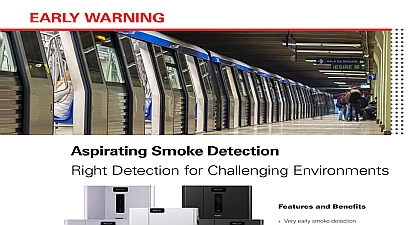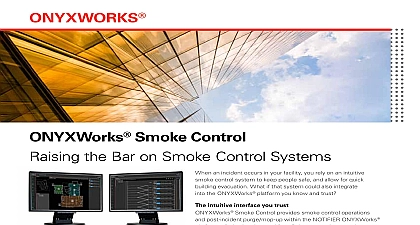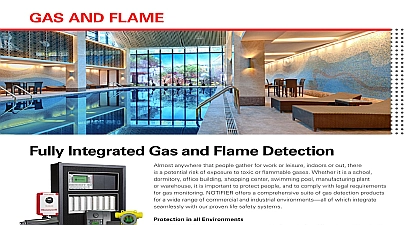Notifier Supervisory Smoke ID Sell Sheet

File Preview
Click below to download for free
Click below to download for free
File Data
| Name | notifier-supervisory-smoke-id-sell-sheet-5783164029.pdf |
|---|---|
| Type | |
| Size | 707.88 KB |
| Downloads |
Text Preview
Supervisory Smoke ID preferred solution where probability of unwarranted is high or where sensitivity is set to an low level for use as maintenance alert Management of Nuisance Alarms common characteristic of highly sensitive smoke sensors is that the stimuli sensors respond to are commonly found in the environment Therefore the sensitive the smoke sensor is the more prone it is to nuisance alarms nuisance alarm occurs when a smoke sensor reacts to stimuli that are under circumstances allowed in the environment and do not represent a hostile Examples are burning toast tobacco smoke release of aerosols such as air hair spray or insecticides and many more When these stimuli trigger a sensor through no direct intent the result is a nuisance alarm Smoke ID programmed into every NOTIFIER ONYX Series fire control provides the ability to use the most sensitive settings on sensors to create a intervention alert instead of a general alarm and without summoning fire department Through Supervisory Smoke ID fire alarm systems today preventive functions that high sensitivity can provide Response to Unwarranted Alarms fundamental change has occurred in the approach to fire systems in multiple dwellings hotels motels and dormitories due to the overwhelming problem unwarranted alarms caused by cooking shower steam and cigarette smoke the new standards a smoke alarm in a dwelling is prohibited from causing general building alarm to sound The new standard is written for dwellings protected by stand alone 120 VAC smoke alarms that sound only in the Using Supervisory Smoke ID intelligent systems can comply with these requirements second requirement is if one smoke alarm goes off all alarms must go off within dwelling unit ONYX Series fire panels meet this requirement through the use of bases and advanced programming NFPA Chapter 11 is clear that smoke in the dwelling cannot cause a General Alarm to sound or result in the of the fire department However heat detectors should cause an alarm two requirements create an interesting complexity that more sophisticated alarm systems like the NOTIFIER ONYX Series can handle much better than wire devices Applications residential applications Supervisory Smoke ID Meets the new NFPA requirements for new apartments hotels motels and to avoid evacuating an entire building caused by a nuisance in one dwelling unit Allows intelligent systems to comply with the requirement for smoke sensors in residential units to sound only in the dwelling where are installed but still have local proprietary monitoring and central notification Allows proprietary monitoring in accordance with NFPA 72 3.3.193.2 reports alarms for investigation on a local basis Business Interruption and Data Loss Smoke ID allows early detection of equipment to reduce or prevent business Fire statistics clearly demonstrate that the of business interruption greatly exceeds the cost with the physical loss of the property itself By the problem in the very early stages maintenance can be alerted to adjust repair or replace the equipment before the fire occurs reducing to minutes instead of days or weeks costly than business interruption is data loss By overheating equipment the loss of data can be or prevented This is especially true for sales and transaction records Supervisory ID also allows monitoring of overheating printed boards without nuisance alarms Applications commercial applications Supervisory Smoke ID Allows smoke sensors placed in equipment enclosures and server telephone rooms to be set at the sensitive setting for quickly sensing overheating prior to serious damage occurring Upon activation these smoke sensors can be at an indicator panel only in the department and not to the building fire staff to avoid alerting others unnecessarily Dispatches maintenance crews to locate investigate repair overheating equipment when smoke is in these critical areas prior to serious equipment or an actual fire Sensitivity Smoke Sensing more sophisticated application of this design feature the use of high sensitivity smoke sensing The design concept is to have the system to materials as they begin to overheat allowing intervention prior to major damage to the this type of system found only in very clean rooms main computer and telephone buildings With low spot type laser sensors the NOTIFIER VIEW Very Early Warning high smoke sensing is in more locations Using an bright controlled laser diode VIEW can the extremely small smoke particles produced in early stages of a fire are numerous locations in every building where high smoke sensing is a real advantage Locations labs with expensive electronic equipment switch gear rooms telephone and internet medical storage facilities museums art and archives Historically people were about creating unnecessary nuisance alarms in areas by installing high sensitivity smoke sensing by using these devices in mode system can alert the operator to investigate but there no need to evacuate or dispatch the fire brigade and Support products and services are offered through Engineered Systems Distributors These are ready to assist you in the design commissioning and management of your fire alarm system learn more about the ONYX Series of fire alarm panels VIEW laser detector or other NOTIFIER products us at www notifier com and ONYX are registered trademarks of Honeywell International Headquarters Clintonville Road CT 06472 1610 USA 203 484 7161 203 484 7118 2005 Honeywell Int 01 06 05


